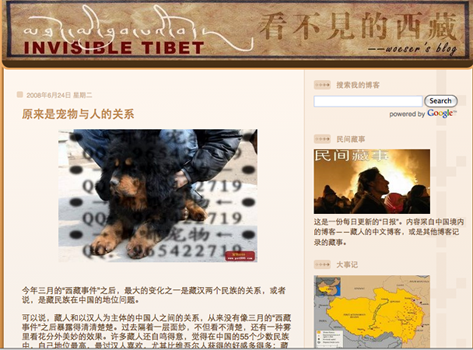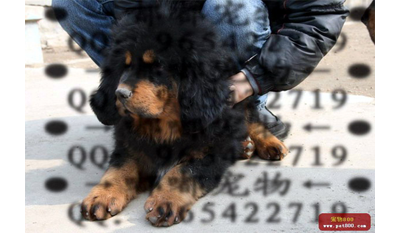This new translation by High Peaks Pure Earth of a blogpost by Woeser from 24th June 2008 focuses on Chinese/Tibetan relations and was written at the height of unrest and tensions that had started in Lhasa on March 10th. It was from 14th March this year that the Han fascination with all things Tibet suddenly stopped, a phenomenon that Woeser examines below. The “Tibetan Incident” that Woeser refers to are the violent incidents that took place in Lhasa on 14th March, footage of which was constantly played on Chinese State TV and news for months and popularly known in China as 3.14 (san yao si).
Tibetans, even those living in Beijing – far away from the Tibetan plateau – felt the difference in their treatment and standing in society. Tibetans were portrayed as violent and out for blood, the Dalai Lama was blamed for the unrest and accused of sabotaging the Olympics and the Tibetan Youth Congress was described by China as “a terror group worse than Bin Laden’s”. By the way, for a truly mind-boggling analysis of the Tibetan Youth Congress, High Peaks Pure Earth recommends this China Daily article!
In her post, Woeser has also documented the fad amongst the Chinese nouveau riche of keeping Tibetan mastiffs as pets. Numerous Chinese websites extol the virtues of the Tibetan mastiff that fetch prices of up to £250,000. For American readers, that is almost half a million dollars! This may be an unexplored export commodity for Tibetan nomads and a possible future development programme for the plateau – thus solving the grasslands degradation problem! At the height of its fashion, The Times of London reported on this phenomenon.
The protests in Tibet and international outcry, the anger and humiliation felt by the Chinese at the Olympic Torch Relay beset by protestors all over the world along with the subsequent anti-CNN and anti-French sentiments in China all sparked a new wave of nationalistic feelings amongst Chinese citizens. In this atmosphere, Woeser travelled to Kham and Amdo and wrote this post on the road in Kunming, Yunnan Province, on 2nd June. More anecdotes about being Tibetan in China by Woeser have been translated into English by Ragged Banner and can be found here.

“An Owner and His Pet – Tibetan/Han Relations”
In the aftermath of the “Tibetan Incident” in March this year, one of the most significant changes has been the relationship between the Han and Tibetan ethnic groups, in other words the question of the status of Tibetans in China.
It can be said that relations between Hans − who make up the majority of Chinese society − and Tibetans have never been so clearly revealed than after the “Tibetan Incident” last March. In the past, it was as though a veil separated the two and this not only made thing unclear but also produced a very beautiful effect similar to looking at a flower through the fog. Moreover, many Tibetans used to sing their own praises and believed that amongst the 55 minorities in China, their status was the highest, their minority was the one most likeable to the Han people, and they in particular meant much more to Chinese people than Uighur people. Tibetan reincarnated lamas and Tibetan monks, for instance, often come and go between Tibetan and Han areas, have numerous Han disciples and feel proud to serve as Hans’ Lamas. However, among the Chinese people there are many so-called “Tibet fans” and some of them call themselves “drifters in Tibet”. Hardly have they spent a few years in Tibet that they find life has no taste. In 2006 when the train entered Lhasa, it seemed that the whole of China started feeling excited about the Qinghai-Tibetan Plateau, and nearly everyone wanted to climb to the Potala. It can be said that it has been a very long time since Hans and Tibetans, I mean the relationship between the common people of the two people, have been permeated by tender feelings that cannot endure the truth.
And after the events in Tibet last March, this veil was lifted. It turns out what many of the Tibetans are satisfied with is just their status of finding favour with the Han among the fifty-five ethnic minorities. Many Han people, be it their love for Tibetans before the events or their hate for Tibetans after the events, have clearly shown that the feelings they nurtured were similar to the feelings of an owner towards its pet. This can be compared to the Tibetan mastiff, the most famous animal living on the Qinghai-Tibetan Plateau. It seems so rare and so valuable that some Chinese tycoons or those who pose as lovers of culture spend vast amounts of money in a rivalry to purchase the mastiff which they also have to feed with lots of meat every day. But one day, the Tibetan mastiff all of a sudden gets angry and bites the person who has become its owner, and the animal is beaten to death on the spot. Chinese newspapers often relate this kind of story. And it perfectly illustrates the relationship between Tibetans and Chinese. This is actually the real and fundamental relations between ethnic groups in Chinese society. If Tibetans are content with being pets, the Han people will maintain the tender feelings they once had towards Tibetans; and just like they are willing to feed cats or dog they like, those Hans will keep on “loving” Tibet. But human beings are not pets: pets do not have a volition of ego, whereas human beings do. Tibetans do not want to be pets, for the consequence of being a pet involves the loss of self, and ultimately the loss of Tibet. Therefore, as long as Tibetans are not content with being pets, or not content with accepting their fate of being pets, and bravely fight for the their being human beings and being Tibetans, then this is what brings trouble. In fact, trouble is already there; Tibetans are sometimes arrested, detained, tortured or even massacred. These are punishments inflicted by the country’s regime. To the Han people who evolve in the non-government sphere, the fact that some Han people changed sides so quickly allowed the truth to surface. And the truth is that Tibetans cannot act as humans. As soon as they do, they are exposed to fatal risks.
Actually, Uighur people obtained the same kind of result a long time ago. The bottom line is that Tibetans and Uighurs are the same: they have not been able to secure a status equal to the Hans in a Chinese society mostly made up of Hans. And this is what was revealed through the events that unfolded last March in Tibet. For many simple-minded and easily satisfied Tibetans, this was like a hit in the face or from another angle, a very significant lesson.
Kunming, 2nd June 2008





Follow Us!